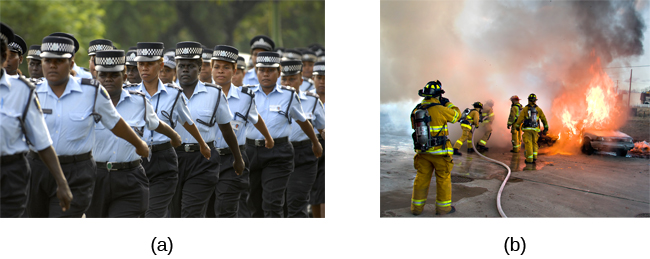| << Chapter < Page | Chapter >> Page > |

| Occupation | Stressors Specific to Occupation (Sulsky&Smith, 2005) |
|---|---|
| Police officer | physical dangers, excessive paperwork, red tape, dealing with court system, coworker and supervisor conflict, lack of support from the public |
| Firefighter | uncertainty over whether a serious fire or hazard awaits after an alarm |
| Social worker | little positive feedback from jobs or from the public, unsafe work environments, frustration in dealing with bureaucracy, excessive paperwork, sense of personal responsibility for clients, work overload |
| Teacher | Excessive paperwork, lack of adequate supplies or facilities, work overload, lack of positive feedback, vandalism, threat of physical violence |
| Nurse | Work overload, heavy physical work, patient concerns (dealing with death and medical concerns), interpersonal problems with other medical staff (especially physicians) |
| Emergency medical worker | Unpredictable and extreme nature of the job, inexperience |
| Air traffic controller | Little control over potential crisis situations and workload, fear of causing an accident, peak traffic situations, general work environment |
| Clerical and secretarial work | Little control over job mobility, unsupportive supervisors, work overload, lack of perceived control |
| Managerial work | Work overload, conflict and ambiguity in defining the managerial role, difficult work relationships |
Although the specific stressors for these occupations are diverse, they seem to share two common denominators: heavy workload and uncertainty about and lack of control over certain aspects of a job. Both of these factors contribute to job strain , a work situation that combines excessive job demands and workload with little discretion in decision making or job control (Karasek&Theorell, 1990). Clearly, many occupations other than the ones listed in [link] involve at least a moderate amount of job strain in that they often involve heavy workloads and little job control (e.g., inability to decide when to take breaks). Such jobs are often low-status and include those of factory workers, postal clerks, supermarket cashiers, taxi drivers, and short-order cooks. Job strain can have adverse consequences on both physical and mental health; it has been shown to be associated with increased risk of hypertension (Schnall&Landsbergis, 1994), heart attacks (Theorell et al., 1998), recurrence of heart disease after a first heart attack (Aboa-Éboulé et al., 2007), significant weight loss or gain (Kivimäki et al., 2006), and major depressive disorder (Stansfeld, Shipley, Head,&Fuhrer, 2012). A longitudinal study of over 10,000 British civil servants reported that workers under 50 years old who earlier had reported high job strain were 68% more likely to later develop heart disease than were those workers under 50 years old who reported little job strain (Chandola et al., 2008).

Notification Switch
Would you like to follow the 'Psychology' conversation and receive update notifications?